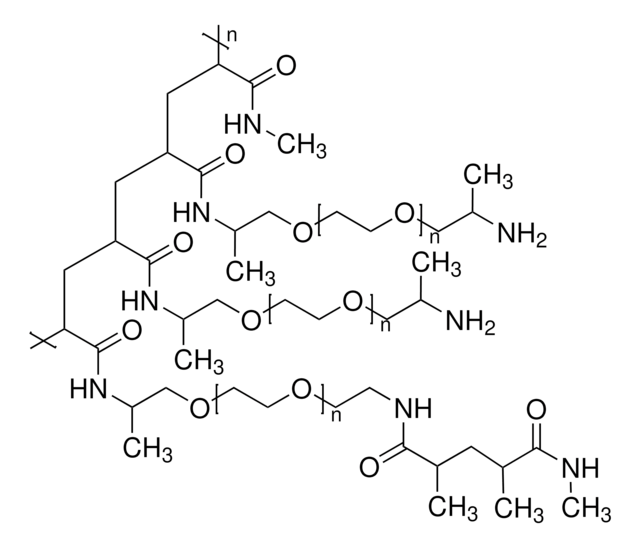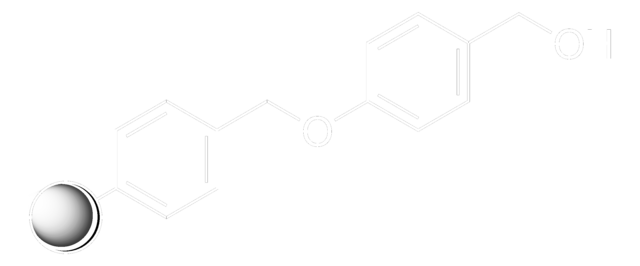8.55015
Amino PEGA resin
Novabiochem®
Synonym(s):
Amino PEGA resin
Sign Into View Organizational & Contract Pricing
All Photos(1)
About This Item
Recommended Products
Quality Level
product line
Novabiochem®
PEGA
form
beads
reaction suitability
reaction type: Fmoc solid-phase peptide synthesis
manufacturer/tradename
Novabiochem®
application(s)
peptide synthesis
functional group
amine
storage temp.
2-8°C
General description
PEGA resins consist of dimethyl acrylamide and mono-2-acrylamidoprop-1-yl[2-aminoprop-1-yl] polyethylene glycol cross-linked with bis 2-acrylamidoprop-1-yl polyethyleneglycol. These supports swell extensively in a wide range of solvents and are permeable to macromolecules up to 35 kD, making them ideal for the preparation of combinatorial libraries, affinity purification and on-resin enzyme assays. For applications of these resins in SPPS and SPOS see [1,2,3,4,5,6,7,8,9,10,11,12,13,14,15,16,17,18].Note: PEGA resins are supplied swollen in ethanol, with 1g dry resin corresponding to approximately 15 mL of swollen resin. As the beads of PEGA resins become very sticky and easily damaged when shrunk or dried, they are best handled in a swollen state. To use, the appropriate amount of swollen resin should be weighed into a reaction vessel and any residual ethanol removed by copious washings with the appropriate solvent or solvent mixture. After peptide assembly, the resin should be washed with DCM and transferred to the cleavage vessel. Excess DCM can be removed under vacuum, and the shrunk resin treated with the TFA cocktail. The characteristics of the swollen resin, its robustness and high permeability enables its use in both batch and continuous flow synthesis apparatus.
Associated Protocols and Technical Articles
Protocols for Loading of Peptide Synthesis Resins Literature references
Literature references
[1] M. Meldal, et al. (1992) Tetrahedron Lett., 33, 3077.
[2] F. I. Auzanneau, et al. (1994) J. Peptide Sci., 1, 31.
[3] M. Meldal in ′Peptides 1992, Proc. 22nd European Peptide Symposium′, C. H. Schneider & A. N. Eberle (Eds), ESCOM, Leiden, 1993, pp.61.
[4] M. Meldal, et al. in ′Innovation & Perspectives in Solid Phase Synthesis, 3rd International Symposium′, R. Epton (Eds), Mayflower Worldwide, Birmingham, 1994, pp. 259.
[5] M. Meldal, et al. (1993) Int. J. Peptide Protein Res., 41, 250.
[6] M. Meldal, et al. (1994) J. Chem. Soc., Chem. Commun., 849.
[7] M. Meldal, et al. (1994) Proc. Natl. Acad. Sci. USA, 91, 3314.
[8] M. Renil, et al. (1998) J. Peptide Sci., 4, 195.
[9] J. C. Spetzler, et al. (1998) J. Peptide Sci., 4,128.
[10] M. Meldal, et al. (1998) J. Peptide Sci., 4 ,83.
[11] J. A. Camarero, et al. (1998) J. Peptide Res., 51, 303.
[12] J. A. Camarero, et al. (2000) Lett. Pept. Sci., 7,17.
[13] O. Melnyk, et al. (2001) J. Org. Chem., 66, 4153.
[14] J. Buchardt, et al. (2000) J. Comb. Chem., 2, 624.
[15] J. F. Tolberg, et al. (2002) J. Org. Chem., 67, 4143.
[16] J. Bondebjerg, et al. (2002) J. Am. Chem. Soc., 124, 11046.
[17] J. Tulla-Puche, et al. (2004) J. Org. Chem., 69, 4101.
[18] S. Aggarwal, et al. (2005) Biomaterials, 26, 6077.
Associated Protocols and Technical Articles
Protocols for Loading of Peptide Synthesis Resins Literature references
Literature references
[1] M. Meldal, et al. (1992) Tetrahedron Lett., 33, 3077.
[2] F. I. Auzanneau, et al. (1994) J. Peptide Sci., 1, 31.
[3] M. Meldal in ′Peptides 1992, Proc. 22nd European Peptide Symposium′, C. H. Schneider & A. N. Eberle (Eds), ESCOM, Leiden, 1993, pp.61.
[4] M. Meldal, et al. in ′Innovation & Perspectives in Solid Phase Synthesis, 3rd International Symposium′, R. Epton (Eds), Mayflower Worldwide, Birmingham, 1994, pp. 259.
[5] M. Meldal, et al. (1993) Int. J. Peptide Protein Res., 41, 250.
[6] M. Meldal, et al. (1994) J. Chem. Soc., Chem. Commun., 849.
[7] M. Meldal, et al. (1994) Proc. Natl. Acad. Sci. USA, 91, 3314.
[8] M. Renil, et al. (1998) J. Peptide Sci., 4, 195.
[9] J. C. Spetzler, et al. (1998) J. Peptide Sci., 4,128.
[10] M. Meldal, et al. (1998) J. Peptide Sci., 4 ,83.
[11] J. A. Camarero, et al. (1998) J. Peptide Res., 51, 303.
[12] J. A. Camarero, et al. (2000) Lett. Pept. Sci., 7,17.
[13] O. Melnyk, et al. (2001) J. Org. Chem., 66, 4153.
[14] J. Buchardt, et al. (2000) J. Comb. Chem., 2, 624.
[15] J. F. Tolberg, et al. (2002) J. Org. Chem., 67, 4143.
[16] J. Bondebjerg, et al. (2002) J. Am. Chem. Soc., 124, 11046.
[17] J. Tulla-Puche, et al. (2004) J. Org. Chem., 69, 4101.
[18] S. Aggarwal, et al. (2005) Biomaterials, 26, 6077.
Application
- Fluorescence-Based On-Resin Detection of Three Model Proteases: Discusses the use of Amino PEGA resin modified with backbone amide linker (BAL) for developing solid support-bound probes used in fluorescence-based assays. (Milicevic & Hlavác, 2021).
- Attachment of cyclodextrin acids to PEGA resin and study of binding with fluorescence microscopy: Investigates the attachment of cyclodextrin to amino PEGA resin and evaluates their binding interactions using fluorescence microscopy. (Langhorn et al., 2021).
Linkage
Replaces: 01-64-0100
Analysis Note
Color (visual): white to yellow to beige
Appearance of substance (visual): beads
Loading (determined from the substitution of the Fmoc-Leu loaded resin): 0.30 - 0.50 mmol/g
Swelling Volume (in DMF): lot specific result
Swelling Volume (in water): lot specific result
dry resin %: lot specific result
The resin is sold swollen in ethanol. 50 - 100 mesh
Appearance of substance (visual): beads
Loading (determined from the substitution of the Fmoc-Leu loaded resin): 0.30 - 0.50 mmol/g
Swelling Volume (in DMF): lot specific result
Swelling Volume (in water): lot specific result
dry resin %: lot specific result
The resin is sold swollen in ethanol. 50 - 100 mesh
Legal Information
Novabiochem is a registered trademark of Merck KGaA, Darmstadt, Germany
Storage Class Code
11 - Combustible Solids
WGK
nwg
Flash Point(F)
Not applicable
Flash Point(C)
Not applicable
Certificates of Analysis (COA)
Search for Certificates of Analysis (COA) by entering the products Lot/Batch Number. Lot and Batch Numbers can be found on a product’s label following the words ‘Lot’ or ‘Batch’.
Already Own This Product?
Find documentation for the products that you have recently purchased in the Document Library.
Customers Also Viewed
Our team of scientists has experience in all areas of research including Life Science, Material Science, Chemical Synthesis, Chromatography, Analytical and many others.
Contact Technical Service









